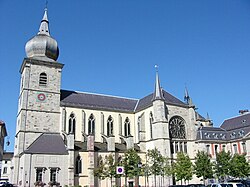Remiremont Abbey
Imperial Abbey of Remiremont | |||||||||
|---|---|---|---|---|---|---|---|---|---|
| 1290–1766 | |||||||||
 | |||||||||
| Status | Imperial Abbey of the Holy Roman Empire | ||||||||
| Capital | Remiremont Abbey | ||||||||
| Government | Principality | ||||||||
| Historical era | Middle Ages | ||||||||
• Abbey founded | 620 | ||||||||
• Became Reichsfrei | 1290 | ||||||||
1566 | |||||||||
• Disestablished | 1766 | ||||||||
| |||||||||
Remiremont Abbey was an abbey, originally founded as a house of Benedictine nuns near Remiremont, Vosges, France. It later became a community of secular canonesses.
History
It was founded about 620 by Romaric, a lord at the court of Chlothar II, who, having been converted by Saint Ame, a monk of Luxeuil, took the habit at Luxeuil. It comprised a monastery of monks, among whose abbots were Saint Ame (570–625), Saint Romaric (580–653) and Saint Adelphus (died 670), and a monastery of nuns, which numbered among its abbesses Saints Mactefelda (died ca 622), Claire (died ca 652) and Gébétrude (died ca 673). Bishop Arnulf of Metz, progenitor of the Arnulfing and Carolingian dynasty, died in the vicinity, probably in the year 640, and was buried in the monastery until his remains were later translated to Metz Cathedral.
In 910 the nuns, menaced by the invasion of the Hungarians armies, took refuge at Remiremont, which had grown up round a villa of the Frankish kings, with a monastery also being founded in the locale, and in the 11th century they permanently settled there. At a later period, the Benedictine nuns were replaced by a chapter of 98 secular canonesses. Enriched by the Dukes of Lorraine, the kings of France and the Holy Roman Emperors, the ladies of Remiremont attained great power. The abbess was raised to the status of Imperial Princess, and received consecration at the hands of the pope. The 50 canonesses were admitted from those who could give proof of 200 years of noble descent. On Whit Monday the neighboring parishes paid homage to the collegiate chapter in a ceremony called the Kyriolés (canticles in the vernacular). On their accession, the Dukes of Lorraine became de facto suzerains of the abbey and had to come to Remiremont to swear to continue their protection.
The "War of the Escutcheons" (Template:Lang-fr in 1566 between the duke and the abbess ended in favor of the duke, and the abbess never recovered her former position. In order to demonstrate their Imperial immediacy and their independence from the Dukes of Lorraine, the canonesses of the abbey mounted escutcheons around the town displaying the Imperial eagle. Charles III, Duke of Lorraine, took advantage of the absence of Emperor Maximilian II, away campaigning in Hungary, to remove the escutcheons by force and establish his de facto sovereignty.
In the 17th century the ladies of Remiremont fell away so much from the original monastic style of life as to take the title of countesses, renounce their vows and marry.
Catherine de Lorraine was an abbess. The office was to be given to her niece, Marguerite, but she married Gaston, Duke of Orléans; the couple's second daughter, Élisabeth Marguerite d'Orléans, became titular abbess, as was Princess Élisabeth Charlotte of Lorraine. Béatrice Hiéronyme de Lorraine was also abbess. Maria Christina of Saxony, sister to the Dauphine Marie Josèphe, was abbess after Anne Charlotte.
Anne Charlotte de Lorraine, an aunt of Marie Antoinette, was an abbess. The last abbess, under the Ancien Régime, was Louise Adélaïde de Bourbon, the daughter of Louis Joseph, Prince of Condé. She was prioress of the Monastery of the Temple at her death in 1824.

See also
References
- This article incorporates text from a publication now in the public domain: Chisholm, Hugh, ed. (1911). Encyclopædia Britannica (11th ed.). Cambridge University Press.
{{cite encyclopedia}}: Missing or empty|title=(help)  This article incorporates text from a publication now in the public domain: Herbermann, Charles, ed. (1913). Catholic Encyclopedia. New York: Robert Appleton Company.
This article incorporates text from a publication now in the public domain: Herbermann, Charles, ed. (1913). Catholic Encyclopedia. New York: Robert Appleton Company. {{cite encyclopedia}}: Missing or empty|title=(help)
- Imperial abbeys
- Former theocracies
- Former principalities
- States of the Holy Roman Empire
- States and territories established in 1290
- States and territories disestablished in 1766
- Monasteries of secular canonesses
- Benedictine monasteries of nuns in France
- Buildings and structures in Vosges
- Carolingian architecture
- Christian monasteries established in the 7th century
- Abbesses of Remiremont
- Churches in Vosges

